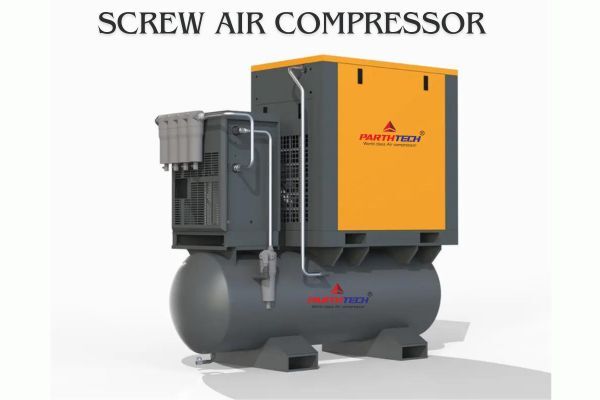-
Call
-
Whatsapp
9825014048
-
Location


Blog


BLOG

Screw Air Compressor
Screw air compressors are vital components in various industrial applications, providing a continuous and efficient source of compressed air. Understanding how these machines work is essential for optimising their performance and ensuring smooth operations in diverse settings. We will examine the principles, components, and uses of screw air compressors in this detailed overview.
A screw air compressor is a type of positive displacement rotary compressor designed to provide a continuous and efficient source of compressed air. Compressing air via a system of interlocking helical rotors or screws is the fundamental basis of operation. There are two main types of screw air compressors: the rotary screw compressor and the reciprocating screw compressor.

Rotary Screw Compressor:
In a rotary screw compressor, two rotors with helical screws are mounted in a precisely designed housing. As the rotors rotate, the air is drawn in through the inlet and is progressively compressed as the rotors move closer together. The compressed air is then discharged through the outlet. Rotary screw compressors are well-suited for a wide range of industrial uses due to their reputation for continuous and smooth operation.
Reciprocating Screw Compressor:
Reciprocating screw compressors, also known as piston-type screw compressors, use a piston-cylinder arrangement to compress air. The piston generates a vacuum as it moves back and forth, drawing air into the cylinder. The air is then compressed as the piston moves back up, and the compressed air is discharged. While reciprocating screw compressors share some similarities with rotary screw compressors, their operation involves more dynamic components.
Many different industries rely on screw air compressors because they are reliable and effective in producing compressed air. This includes construction, manufacturing, the automobile industry, and many more. Their ability to deliver a continuous supply of compressed air, energy efficiency, and relatively low maintenance requirements make them popular in industrial settings.
How Does an Air Compressor Work?
A screw air compressor works on the principle of positive displacement to compress air and generate a continuous supply of high-pressure compressed air. There are two main types of screw air compressors: rotary screw compressors and reciprocating screw compressors.
Rotary Screw Compressor:
Intake of Air:
The process begins with ambient air intake through a filter, removing contaminants such as dust and moisture.
Compression Chamber:
The filtered air enters the compression chamber, where two helical rotors (screws) are positioned. These screws are typically male and female with complementary lobes.
Compression Process:
As the rotors rotate, air is trapped in the spaces between the lobes and progressively compressed as the screws move closer together. The compression is continuous, providing a steady output of compressed air.
Pressure Increase:
The compressed air's pressure significantly increases as it moves through the screw elements. The specific design and operation of the screws determines the compression ratio.
Cooling:
The compressed air may heat up during the compression process. Most rotary screw compressors incorporate a cooling system, either air or water-cooled, to dissipate this heat and prevent excessive temperatures.
Discharge of Compressed Air:
The compressed and cooled air is then discharged through an outlet. The discharge pressure can be adjusted to meet the application's specific requirements.
Control System:
Many modern rotary screw compressors feature sophisticated control systems that adjust the compressor speed to match the air demand. This helps optimise energy efficiency and extends the compressor's lifespan.
Reciprocating Screw Compressor:
Intake of Air:
Similar to rotary screw compressors, the process begins with the intake of ambient air through a filter.
Compression Chamber:
The filtered air enters a compression chamber where a reciprocating piston or screw moves back and forth within a cylinder. This motion creates a vacuum, drawing air into the cylinder.
Compression Process:
As the piston or screw moves back up, the air is compressed within the cylinder. The reciprocating motion alternately creates suction and compression strokes.
Pressure Increase:
The pressure of the compressed air increases during the compression stroke. The compression ratio is influenced by the size of the cylinder and the stroke length.
Cooling:
Similar to rotary screw compressors, reciprocating screw compressors may incorporate cooling mechanisms to manage the heat generated during compression.
Discharge of Compressed Air:
The compressed air is then discharged through an outlet for various applications.


FAQs

